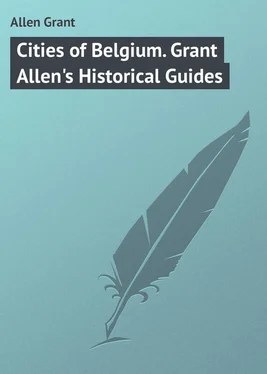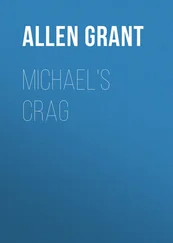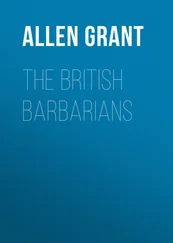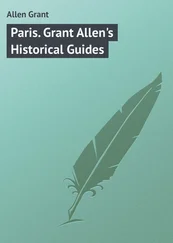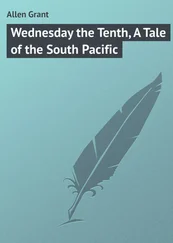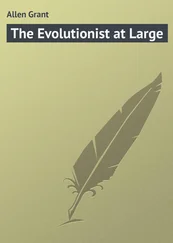Grant Allen - Cities of Belgium. Grant Allen's Historical Guides
Здесь есть возможность читать онлайн «Grant Allen - Cities of Belgium. Grant Allen's Historical Guides» — ознакомительный отрывок электронной книги совершенно бесплатно, а после прочтения отрывка купить полную версию. В некоторых случаях можно слушать аудио, скачать через торрент в формате fb2 и присутствует краткое содержание. ISBN: , Издательство: Иностранный паблик, Жанр: foreign_language, foreign_prose, на английском языке. Описание произведения, (предисловие) а так же отзывы посетителей доступны на портале библиотеки ЛибКат.
- Название:Cities of Belgium. Grant Allen's Historical Guides
- Автор:
- Издательство:Иностранный паблик
- Жанр:
- Год:неизвестен
- ISBN:http://www.gutenberg.org/ebooks/49690
- Рейтинг книги:3 / 5. Голосов: 1
-
Избранное:Добавить в избранное
- Отзывы:
-
Ваша оценка:
- 60
- 1
- 2
- 3
- 4
- 5
Cities of Belgium. Grant Allen's Historical Guides: краткое содержание, описание и аннотация
Предлагаем к чтению аннотацию, описание, краткое содержание или предисловие (зависит от того, что написал сам автор книги «Cities of Belgium. Grant Allen's Historical Guides»). Если вы не нашли необходимую информацию о книге — напишите в комментариях, мы постараемся отыскать её.
Cities of Belgium. Grant Allen's Historical Guides — читать онлайн ознакомительный отрывок
Ниже представлен текст книги, разбитый по страницам. Система сохранения места последней прочитанной страницы, позволяет с удобством читать онлайн бесплатно книгу «Cities of Belgium. Grant Allen's Historical Guides», без необходимости каждый раз заново искать на чём Вы остановились. Поставьте закладку, и сможете в любой момент перейти на страницу, на которой закончили чтение.
Интервал:
Закладка:
The local manufacturesof Flanders consisted chiefly of woollen goods and linens; the imports included Italian luxuries, Spanish figs and raisins, Egyptian dates, Oriental silks, English wool, cattle, and metals, Rhenish wines, and Baltic furs, skins, and walrus tusks.
In the early 16th century, when navigation had assumed new conditions, and trade was largely diverted to the Atlantic, Antwerp, the port of the Schelde, superseded the towns on the inland network. As Venice sank, Antwerp rose.
The artthat grew up in the Flemish cities during their epoch of continuous commercial development bears on its very face the visible impress of its mercantile origin. France is essentially a monarchical country, and it is centralized in Paris; everything in old French art is therefore regal and lordly. The Italian towns were oligarchies of nobles; so the principal buildings of Florence and Venice are the castles or palaces of the princely families, while their pictures represent the type of art that belongs in its nature to a cultivated aristocracy. But in Flanders, everything is in essence commercial. The architecture consists mainly, not of private palaces, but of guilds, town halls, exchanges, belfries: the pictures are the portraits of solid and successful merchants, or the devotional works which a merchant donor presented to the patron saint of his town or business. They are almost overloaded with details of fur, brocade, jewellery, lace, gold, silver, polished brass, glasswork, Oriental carpets, and richly carved furniture. In order to understand Flemish art, therefore, it is necessary to bear in mind at every step that it is the art of a purely commercial people.
Another point which differentiates Flemish painting from the painting of Italy during the same period is the complete absence of any opportunity for the display of frescoes. In the Italian churches, where the walls serve largely for support, and the full southern light makes the size of the windows of less importance, great surfaces were left bare in the nave and aisles, or in the lower part of the choir, crying aloud for decoration at the hands of the fresco-painter. But in the northern Gothic, which aimed above all things at height and the soaring effect, and which almost annihilated the wall, by making its churches consist of rows of vast windows with intervening piers or buttresses, the opportunity for mural decoration occurred but seldom. The climate also destroyed frescoes. Hence the works of pictorial art in Flemish buildings are almost confined to altar-pieces and votive tablets. Again, the great school of painting in early Italy (from Giotto to Perugino) was a school of fresco-painters; but in Flanders no high type of art arose till the discovery of oil-painting. Pictures were usually imported from the Rhine towns. Hence, pictorial art in the Low Countries seems to spring almost full-fledged, instead of being traceable through gradual stages of evolution as in Italy. Most of the best early paintings are small and highly finished; it was only at a comparatively late date, when Antwerp became the leading town, that Italian influence began to produce the larger and coarser canvases of Rubens and his followers.
Very early Flemish artgreatly resembles the art of the School of Cologne. Only with Hubert and Jan van Eyck (about 1360-1440) does the distinctively Flemish taste begin to show itself – the taste for delicate and minute workmanship, linked with a peculiar realistic idealism, more dainty than German work, more literal than Italian. It is an art that bases itself upon truth of imitation and perfection of finish: its chief æsthetic beauty is its jewel-like colour and its wealth of decorative adjuncts. The subsequent development of Flemish painting – the painting that pleased a clique of opulent commercial patrons – we shall trace in detail in the various cities.
Whoever wishes to gain a deeper insight into Flemish painting should take in his portmanteau Sir Martin Conway’s “Early Flemish Artists,”a brilliant and masterly work of the first importance, to which this Guide is deeply indebted.
The political historyof the country during this flourishing period of the Middle Ages has also stamped itself, though somewhat less deeply, on the character of the towns and of the art evolved in them. The Counts of Flanders, originally mere lords of Bruges and its district, held their dominions of the Kings of France. Their territory included, not only Arras (at first the capital, now included in France) with Bruges, Ghent, Courtrai, Tournay, and Ypres, but also the towns and districts of Valenciennes, Lille, and St. Omer, which are now French. From the time of Baldwin VIII. (1191), however, Arras became a part of France, and Ghentwas erected into the capital of Flanders. In the beginning of the 13th century, two women sovereigns ruled in succession; under them, and during the absence of the elective Counts on crusades, the towns rose to be practically burgher republics. Bruges, Ypres, Ghent, and Lille were said to possess each 40,000 looms; and though this is certainly a mediæval exaggeration, yet the Flemish cities at this epoch were at any rate the chief manufacturing and trading centres of northern Europe, while London was still a mere local emporium.
In the 14th century, the cities acquired still greater freedom. The citizens had always claimed the right to elect their Count; and the people of Ghent now made treaties without him on their own account with Edward III. of England. To this age belongs the heroic period of the Van Arteveldes at Ghent, when the burghers became the real rulers of Flanders, as will be more fully described hereafter. In 1384, however, Count Louis III. died, leaving an only daughter, who was married to Philip the Bold of Burgundy; and the wealthy Flemish towns thus passed under the sway of the powerful princes of Dijon. Brabant fell later by inheritance to Philip the Good. It was under the Burgundian dynasty, who often held their court at Ghent, that the arts of the Netherlands attained their first great development. Philip the Good (1419-1467) employed Jan van Eyck as his court painter; and during his reign or just after it the chief works of Flemish art were produced in Bruges, Ghent, Brussels, and Tournai.
Charles the Bold, the last Duke of Burgundy, left one daughter, Mary, who was married to Maximilian, afterwards Emperor. From that date forward the history of the Flemish towns is practically merged in that of the dynasty of Charles V., and finally becomes the story of an unwilling and ever justly rebellious Spanish province. The subsequent vicissitudes of Belgium as an Austrian appanage, a part of Holland, and an independent kingdom, belong to the domain of European history. For the visitor, it is the period of the Burgundian supremacy that really counts in the cities of Belgium.
Yet the one great point for the tourist to bear in mind is really this – that the art of the Flemish towns is essentially the art of a group of burgher communities. It is frankly commercial, neither royal nor aristocratic. In its beginnings it develops a strictly municipal architecture, with a school of painters who aimed at portraiture and sacred panel pictures. After the Reformation had destroyed sacred art in Holland, painting in that part of the Netherlands confined itself to portraits and to somewhat vulgar popular scenes: while in Belgium it was Italianised, or rather Titianised and Veronesed, by Rubens and his followers. But in its best days it was national, local, and sacred or personal.
Take Conway’s “Early Flemish Artists”with you in your portmanteau, and read over in the evening his account of the works you have seen during the day.
Читать дальшеИнтервал:
Закладка:
Похожие книги на «Cities of Belgium. Grant Allen's Historical Guides»
Представляем Вашему вниманию похожие книги на «Cities of Belgium. Grant Allen's Historical Guides» списком для выбора. Мы отобрали схожую по названию и смыслу литературу в надежде предоставить читателям больше вариантов отыскать новые, интересные, ещё непрочитанные произведения.
Обсуждение, отзывы о книге «Cities of Belgium. Grant Allen's Historical Guides» и просто собственные мнения читателей. Оставьте ваши комментарии, напишите, что Вы думаете о произведении, его смысле или главных героях. Укажите что конкретно понравилось, а что нет, и почему Вы так считаете.
